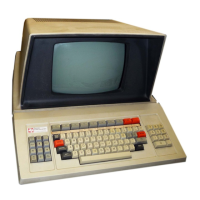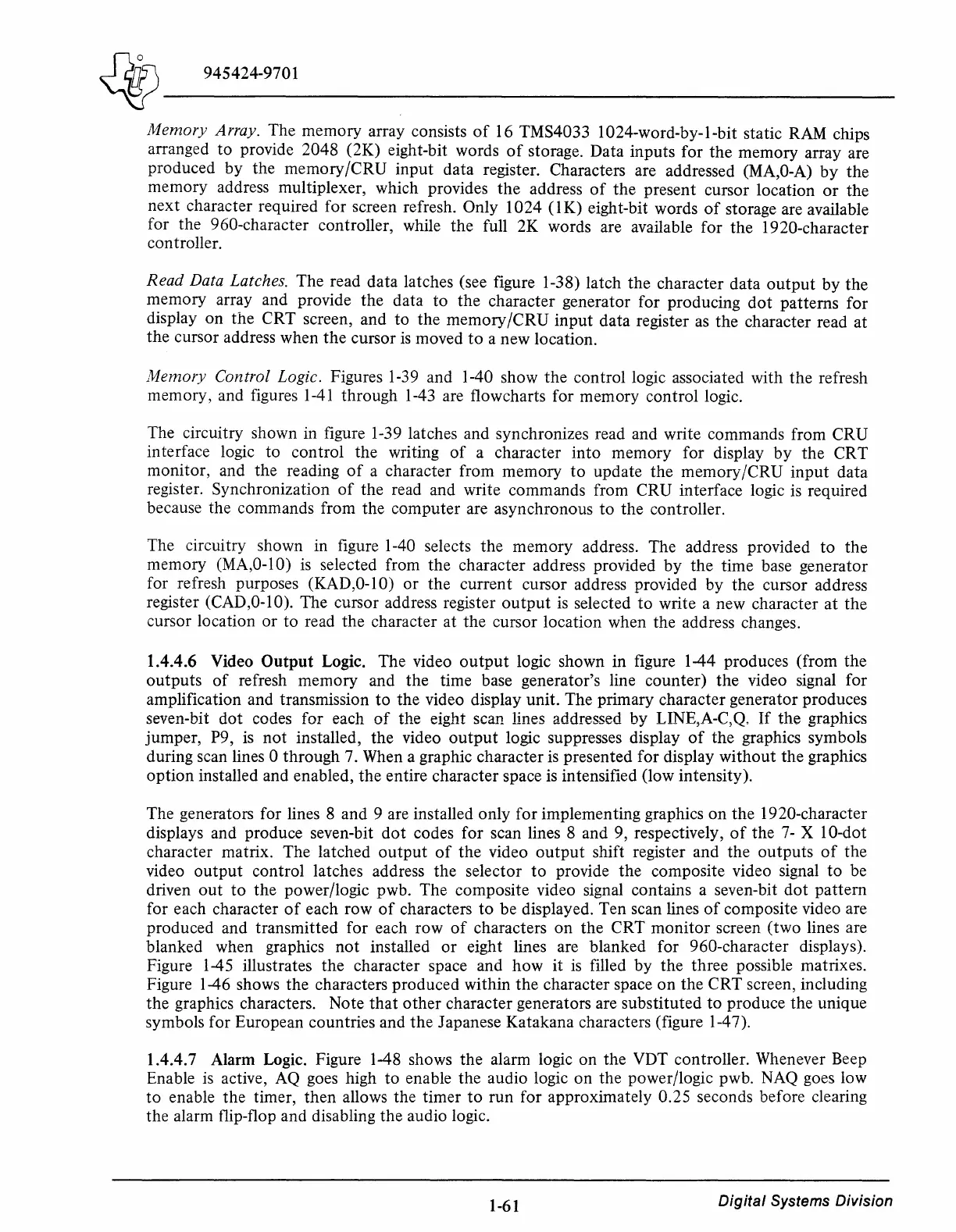~~-------~~~-----
~
945424-9701
Memory Array. The memory array consists
of
16 TMS4033 1024-word-by-l-bit static
RAM
chips
arranged
to
provide 2048 (2K) eight-bit words
of
storage. Data inputs for the memory array are
produced by the memory/CRU input data register. Characters are addressed (MA,0-A)
by
the
memory address multiplexer, which provides the address
of
the present cursor location
or
the
next character required for screen refresh. Only 1024 ( 1 K) eight-bit words
of
storage are available
for the 960-character controller, while the full 2K words are available for the 1920-character
controller.
Read
Data Latches. The read data latches (see figure 1-38) latch the character data
output
by the
memory array and provide the data
to
the character generator for producing
dot
patterns for
display on the CRT screen, and
to
the memory/CRU input data register
as
the character read at
the cursor address when the cursor
is
moved
to
a new location.
Memory Control Logic. Figures 1-39 and 1-40 show the control logic associated with the refresh
memory, and figures
1-41
through 1-43 are flowcharts for memory control logic.
The circuitry shown in figure 1-39 latches and synchronizes read and write commands from CRU
interface logic to control the writing
of
a character into memory for display
by
the CRT
monitor, and the reading
of
a character from memory
to
update the memory/CRU input data
register. Synchronization
of
the read and write commands from CRU interface logic
is
required
because the commands from the computer are asynchronous
to
the controller.
The circuitry shown in figure 1-40 selects the memory address. The address provided
to
the
memory (MA,0-10)
is
selected from the character address provided
by
the time base generator
for refresh purposes (KAD,0-10)
or
the current cursor address provided by the cursor address
register (CAD,0-10). The cursor address register
output
is selected
to
write a new character
at
the
cursor location
or
to read the character at the cursor location when the address changes.
1.4.4.6 Video
Output
Logic. The video
output
logic shown in figure 1-44 produces (from the
outputs
of
refresh memory and the time base generator's line counter) the video signal for
amplification and transmission
to
the video display unit. The primary character generator produces
seven-bit dot codes for each
of
the eight scan lines addressed by LINE,A-C,Q.
If
the graphics
jumper, P9,
is
not installed, the video
output
logic suppresses display
of
the graphics symbols
during scan lines 0 through 7. When a graphic character is presented for display without the graphics
option installed and enabled, the entire character space is intensified (low intensity).
The generators for lines 8 and 9 are installed only for implementing graphics
on
the 1920-character
displays and produce seven-bit
dot
codes for scan lines 8 and 9, respectively,
of
the
7-
X 10-dot
character matrix. The latched
output
of
the video
output
shift register and the outputs
of
the
video
output
control latches address the selector
to
provide the composite video signal
to
be
driven
out
to
the power/logic pwb. The composite video signal contains a seven-bit
dot
pattern
for each character
of
each row
of
characters
to
be displayed. Ten scan lines
of
composite video are
produced and transmitted for each row
of
characters on the CRT
monitor
screen (two lines are
blanked when graphics
not
installed
or
eight lines are blanked for 960-character displays).
Figure
1-45
illustrates the character space and how it
is
filled by the three possible matrixes.
Figure 1-46 shows the characters produced within the character space
on
the CRT screen, including
the graphics characters. Note
that
other
character generators are substituted
to
produce the unique
symbols for European countries and the Japanese Katakana characters (figure
1-4
7).
1.4.4.7 Alarm Logic. Figure 1-48 shows the alarm logic on the VDT controller. Whenever Beep
Enable
is
active,
AQ
goes high to enable the audio logic on the power/logic pwb. NAQ goes low
to enable the timer, then allows the timer
to
run for approximately 0.25 seconds before clearing
the alarm flip-flop and disabling the audio logic.
1-61
Digital
Systems Division

